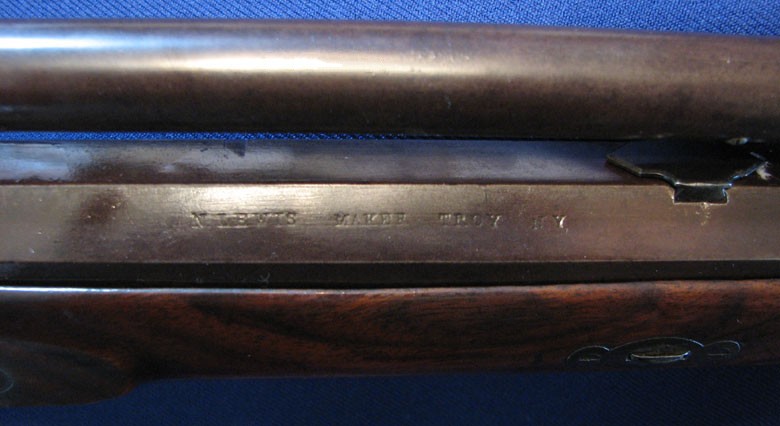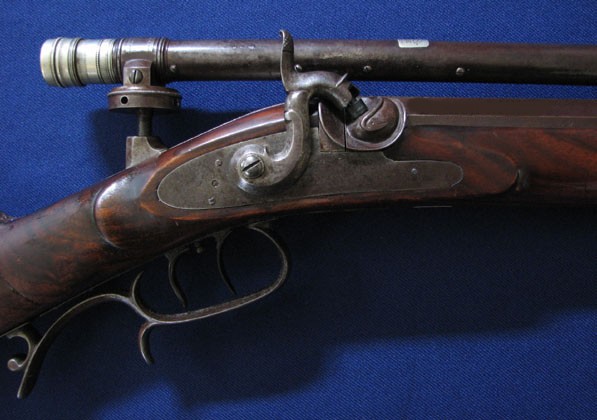
Sharpshooter Target Rifles with Telescopic Sights

Some men brought their own target rifles to Camp of Instruction, which although quite accurate were not designed for war. Each rifle was hand made and designed for competitive shooting or possibly hunting if light enough to carry. They were generally of a smaller caliber than military muskets and the caliber of these rifles varied widely. Some of the target rifles had a telescopic sight that ran the entire length of the barrel. Most of them had heavy octagon barrels and weight varied between 14 and 30 lbs.
Many of these competitive target rifles were manufactured with a false muzzle,
which was inserted on the end of the barrel and was aligned by pins that
inserted into the muzzle. The false muzzle was tapered internally to allow easy
loading, then removed before firing. To help the rifleman remember to remove it
before firing, false muzzles had a sight block that blocked your ability to
see through the sight if it was in place. Because the false muzzle was made with
the rifle, if it was lost, it could not be replaced and the rifle would be
difficult to load without damaging the sharp edge of the barrel. The end of the muzzle could be easily damaged, which would
negatively affect the accuracy of the rifle.
The first documented telescopic rifle sight was invented between 1835 and 1840 by John R. Chapman, he was an English civil engineer, and as an engineer he was very familiar with a surveyors transit and therefore was very familiar with it’s fine cross-hairs, precision lenses and good definition of distant objects. He was also an expert rifleman and familiar with rifle sights of that time. It is believed that Chapman designed the first practical telescopic rifle sight and that he and Morgan James worked together to produce a telescopic sight that came to be known as the Chapman-James telescopic rifle sight.
Chapman did not patent his telescopic sight, but authorized Morgan James to manufacture and sell his telescopic sight.
Morgan James of Utica NY was a well-known gun maker who produced very accurate muzzle-loading rifles, he was considered to have made some of the most accurate muzzle-loading rifles in the world. When he started producing telescopic sights for his rifles they were considered to be among the most accurate rifles made.
Ned H Roberts, author of the book, “The Muzzle-Loading Cap Lock Rifle”, stated the following about the Morgan James rifles;
The reader will be obliged to search for a long time before he finds any rifle, of any make, kind or calibre, old or the most modern, which will shoot a 10-shot group at 40 rods that is entirely enclosed in a circle but one and 27/50 inches in diameter.
Note that a “rod” is 5.5 yards, that’s 220 yards. For those of you who are not shooters, that’s very good shooting even with modern rifles of today. Below is a photo of a rifle and shot group made by a Morgan James rifle that is in the West Point museum. It was made at 40 rods. It was purchased in 1860 by Lt. Holabird, the Adjutant of the U.S. Military Academy, for the sum of $95.00. It was purchased to provide an example of the improved rifle of that time for the “model and small arms room” at West Point; this room later became the West Point Museum. Firearm examples were procured from all over the world for testing and education of the Cadets.


Note that the shot outside the circle is a “sighting” shot, then the scope was adjusted and the following ten shots were fired.
According to documents obtained by Ned Roberts while doing research for his book, Morgan James produced many heavy muzzle-loading sharpshooters’ rifles for Berdan’s Sharpshooters and other US Army units during the Civil War, many of which were equipped with telescopic sights.
Because Chapman had not patented his telescopic sight and mounts, it wasn’t long before other gun makers tried to copy his telescopic sight and mounts, but most other gun makers of the day were not knowledgeable about optical principles, their sights were not adjustable for different ranges, they couldn’t be focused for an individuals eyes and their telescopic sights were so poorly constructed that expert riflemen of the day considered them to be almost useless as a reliable sight.
The Morgan James sights were considered to be the best telescopic sights available until 1855 when William Malcolm, of Syracuse NY designed and produced a telescopic sight.
Malcolm established the first rifle telescope manufacturing business in this country in 1855, he produced the best telescopic rifle sight up to that time and it was considered superior to any other telescopic sights made for many years. Malcolm did not copy the Chapman-James design; while working for a telescope maker he had learned optical principles, how to make lenses, the importance of precise lens adjustment and to fabricate the metal tubes to hold lenses.
Malcolm also was the first to use achromatic lenses, which are a combination of lenses that limit color refraction in an optical piece. Achromatic lenses gave a much better definition of the target, a flatter field of view and a clear definition at the edge of any object. He also made the windage and elevation adjustments more precise than the Chapman-James sight. All of these design improvements were due to his telescope making experience.
The telescopic rifle sights he produced were between 3X and 20X power and considered to be the best available at that time; they had lenses ground for the “normal eye” or were custom ground for the person purchasing the telescopic sight. They were not adjustable and therefore the telescopic sight could generally only be used by the person for whom it was made unless your eyesight was “normal”. I’m not sure what “normal” was at that time, I assume he calibrated the sight to someone he used for that purpose or perhaps to his own eye. I haven’t found a description of what Malcolm considered “normal”.
Non-achromatic lenses have a "halo" of rainbow colors around the edges of the view field and therefore are not as clear, but that is what other telescopic sight makers used at that time.
Another telescopic sight maker was L.M. Amidon of Vermont, a jeweler and expert rifleman, he also designed and produced telescopic sights before and during the war, although none of his telescopic sights had achromatic lenses, they were still considered very good scopes for their time.
Another unique item for accurate shooting is a false muzzle. The false
muzzle was invented by a famous American telescope maker, Alvin Clark, while he
was experimenting with early telescopic sight designs.
The false muzzle was patented and licensed to a gun maker named Edwin Wesson
(1811-1849), who also produced one of the finest muzzle loading rifles of his
day.
The false muzzle covers the muzzle, and has a deeply chambered crown and tapered bore to start the bullet easily and precisely. The false muzzle must be made from the barrel blank, and rifled as part of the barrel.
After loading, the false muzzle is removed to allow the bullet to be fired from a perfect sharp edge muzzle, with no crown. A sharp edge muzzle has been proven to give the best accuracy. During the loading procedure a sharp edge muzzle is easily damaged by careless handling, a false muzzle helps preserve the sharp edge of a muzzle and thereby preserving the accuracy of the rifle.
False muzzles have a small post, called a sight block, which alerts the shooter if he has failed to remove the false muzzle before firing.
Wesson rifle with false muzzle and bullet starter

Globe sights were available at that time and helped to improve the sight picture, but did not increase magnification in any way. -- R.W. Simmons
Photos of original scoped rifle and mounts.





